Economic order quantity (EOQ) versus just-in-time (JIT)
53 Pages11938 Words52 Views
Added on 2021-09-19
Economic order quantity (EOQ) versus just-in-time (JIT)
Added on 2021-09-19
ShareRelated Documents
Running head: DISSERTATION
Dissertation
Name of the Student
Name of the University
Author Note
Dissertation
Name of the Student
Name of the University
Author Note
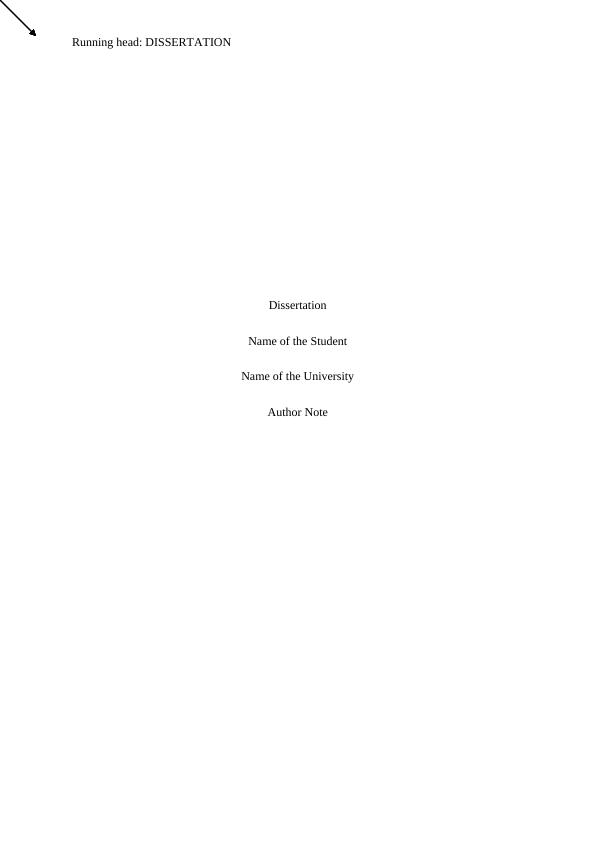
DISSERTATION1
Abstract
This research project is based on the effectiveness of Economic Order Quantity and Just in
Time in Warehouse Management System. The study applies a primary research method in
which an organization called “Hay Diary Ltd” has been considered. Major purpose of
research is to identify the level of efficiency between Just in Time and Economic Order
Quantity in warehouse management system. When analysing the effectiveness of both the
methods in WMS, findings of existing papers indicate Economic Order Quantity method is an
effective option for large businesses. To perform the study, primary data collection method
has been applied, in which data has been collected by performing an online survey among 50
employees of Hay Diary Ltd in Singapore. As organizational members of the organization
have been engaged in the study, non-probability convenient sampling method was the best
choice for the study. Findings imply that both EOQ and JIT are effective on its own way in
relation to market demands and financial stability but when the small scale company would
rather choose Just in Time, when it comes to managing inventory. Small business does not
take the challenge from a dynamic market environment, where the number of similar business
is growing
Abstract
This research project is based on the effectiveness of Economic Order Quantity and Just in
Time in Warehouse Management System. The study applies a primary research method in
which an organization called “Hay Diary Ltd” has been considered. Major purpose of
research is to identify the level of efficiency between Just in Time and Economic Order
Quantity in warehouse management system. When analysing the effectiveness of both the
methods in WMS, findings of existing papers indicate Economic Order Quantity method is an
effective option for large businesses. To perform the study, primary data collection method
has been applied, in which data has been collected by performing an online survey among 50
employees of Hay Diary Ltd in Singapore. As organizational members of the organization
have been engaged in the study, non-probability convenient sampling method was the best
choice for the study. Findings imply that both EOQ and JIT are effective on its own way in
relation to market demands and financial stability but when the small scale company would
rather choose Just in Time, when it comes to managing inventory. Small business does not
take the challenge from a dynamic market environment, where the number of similar business
is growing

DISSERTATION2
Table of Content
CHAPTER 1: INTRODUCTION..............................................................................................4
1.1 Background......................................................................................................................4
1.2 Research Problem.............................................................................................................5
1.3 Research questions and Objectives..................................................................................5
1.4 Research Scope................................................................................................................6
1.5 Research Significance......................................................................................................6
1.6 Summary..........................................................................................................................7
CHAPTER 2: LITERATURE REVIEW...................................................................................8
2.1 Introduction......................................................................................................................8
2.2 Warehouse management system......................................................................................8
2.3 Warehouse management and its elements........................................................................9
2. 3.1 Use of economic order quantity in inventory management system.......................11
2.4 Role of Just-in-time in inventory management..............................................................12
2.5 EOQ and JIT inventory management system.................................................................13
2.6 Inventory management...................................................................................................15
2.7 Inventory management through JIT technique..............................................................17
2.8 Gaps in the literature......................................................................................................18
2.9 Conceptual Framework..................................................................................................20
CHAPTER 3 –RESEARCH METHODOLOGY.....................................................................21
3.1 Introduction....................................................................................................................21
3.2 Research Investigation...................................................................................................21
Table of Content
CHAPTER 1: INTRODUCTION..............................................................................................4
1.1 Background......................................................................................................................4
1.2 Research Problem.............................................................................................................5
1.3 Research questions and Objectives..................................................................................5
1.4 Research Scope................................................................................................................6
1.5 Research Significance......................................................................................................6
1.6 Summary..........................................................................................................................7
CHAPTER 2: LITERATURE REVIEW...................................................................................8
2.1 Introduction......................................................................................................................8
2.2 Warehouse management system......................................................................................8
2.3 Warehouse management and its elements........................................................................9
2. 3.1 Use of economic order quantity in inventory management system.......................11
2.4 Role of Just-in-time in inventory management..............................................................12
2.5 EOQ and JIT inventory management system.................................................................13
2.6 Inventory management...................................................................................................15
2.7 Inventory management through JIT technique..............................................................17
2.8 Gaps in the literature......................................................................................................18
2.9 Conceptual Framework..................................................................................................20
CHAPTER 3 –RESEARCH METHODOLOGY.....................................................................21
3.1 Introduction....................................................................................................................21
3.2 Research Investigation...................................................................................................21
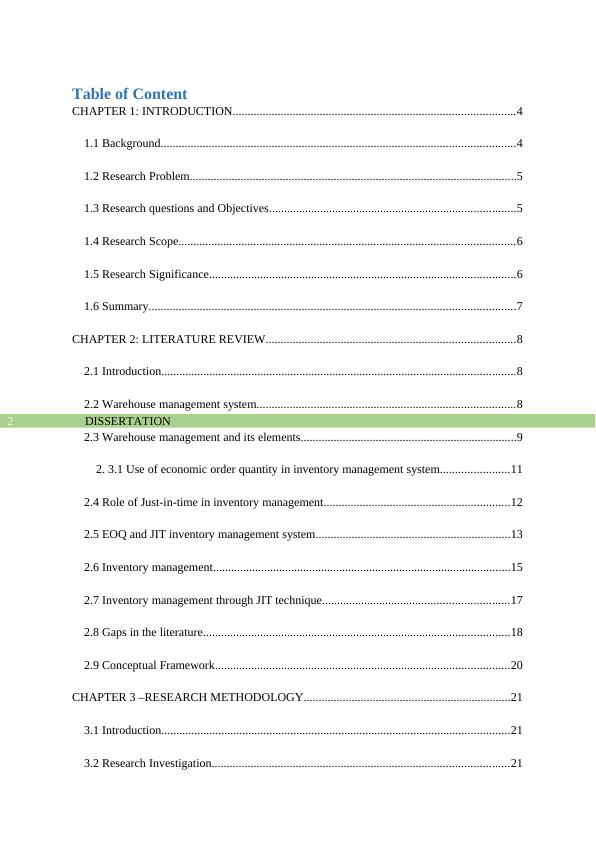
DISSERTATION3
3.3 Research Paradigm/ Philosophy.....................................................................................22
3.4 Research Approaches.....................................................................................................23
3.5 Research Designs...........................................................................................................23
3.6 Data Collection method..................................................................................................24
3.7 Research Setting and Instrument....................................................................................25
3.8 Sampling........................................................................................................................25
3.9 Data Analysis.................................................................................................................26
3.10 Ethical consideration....................................................................................................26
CHAPTER 4: RESEARCH FINDINGS AND ANALYSIS...................................................27
4.1 Introduction....................................................................................................................27
4.2 Quantitative Data...........................................................................................................27
CHAPTER 5: CONCLUSION AND RECOMMENDATION................................................48
5.1 Conclusion......................................................................................................................48
5.2 Recommendation............................................................................................................49
References................................................................................................................................50
3.3 Research Paradigm/ Philosophy.....................................................................................22
3.4 Research Approaches.....................................................................................................23
3.5 Research Designs...........................................................................................................23
3.6 Data Collection method..................................................................................................24
3.7 Research Setting and Instrument....................................................................................25
3.8 Sampling........................................................................................................................25
3.9 Data Analysis.................................................................................................................26
3.10 Ethical consideration....................................................................................................26
CHAPTER 4: RESEARCH FINDINGS AND ANALYSIS...................................................27
4.1 Introduction....................................................................................................................27
4.2 Quantitative Data...........................................................................................................27
CHAPTER 5: CONCLUSION AND RECOMMENDATION................................................48
5.1 Conclusion......................................................................................................................48
5.2 Recommendation............................................................................................................49
References................................................................................................................................50
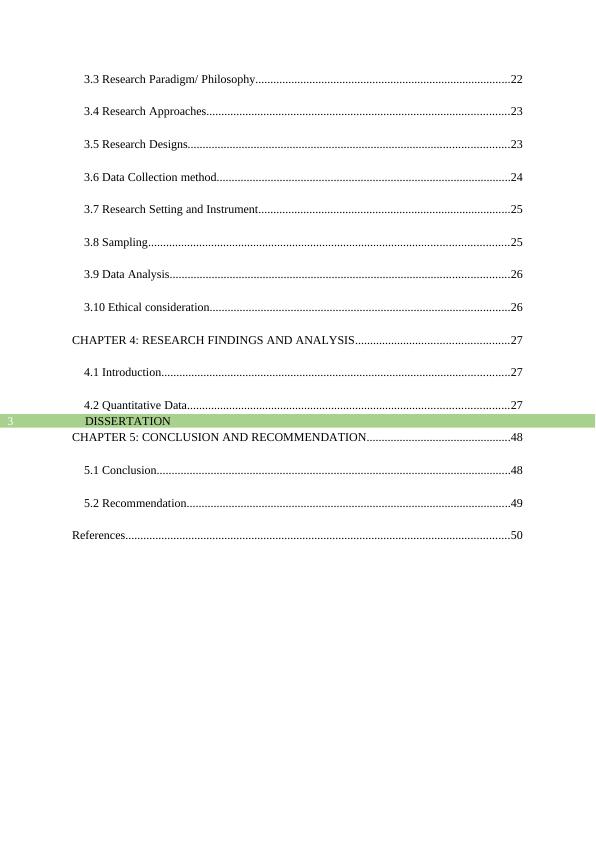
DISSERTATION4
Title- Measuring effectiveness of warehouse management system in a smaller scale
company between EOQ and JIT
CHAPTER 1: INTRODUCTION
1.1 Background
This research project is a detailed analysis of measuring effectiveness of warehouse
management system in smaller scale of business between Economic Order Quantity and Just-
in-time system. Thus, the study has considered Hay Dairy Pte Ltd to measure the
effectiveness of the techniques JIT and EOQ in warehouse management system. The major
purpose of the research is to identify effectiveness between EOQ and JIT in warehouse
management system in small business like Hay Dairy Pte Ltd. The study aims to investigate
the factors as well as warehouse techniques to apply and find out how a small business can
gain benefits from a warehouse system between EOQ and JIT. Richards (2017) performed a
study on warehouse management system and mentioned that warehouse management is an
act of organizing as well as controlling everything within the warehouse and ensure it
operates in the most suitable and optimal way. The process may include the arrangement of
the warehouse and its inventory, maintenance of the equipment, managing the new stock,
packing, shipping and many more tasks. When it comes to measuring the effectiveness of
warehouse management with the techniques, EOQ is worth considering.
According to Chen et al., (2013) economic order quantity (EOQ) plays a great role in
inventory management and this model has been a great topic for academic researchers in the
field. The Economic Order Quantity is basically number of units that a business should add to
inventory with each time to reduce the cost of inventory including the holding cost and
shortage cost. Another significant point in this model is that EOQ is a relevant tool for small
business owners who are required to make decisions regarding how much inventory should
Title- Measuring effectiveness of warehouse management system in a smaller scale
company between EOQ and JIT
CHAPTER 1: INTRODUCTION
1.1 Background
This research project is a detailed analysis of measuring effectiveness of warehouse
management system in smaller scale of business between Economic Order Quantity and Just-
in-time system. Thus, the study has considered Hay Dairy Pte Ltd to measure the
effectiveness of the techniques JIT and EOQ in warehouse management system. The major
purpose of the research is to identify effectiveness between EOQ and JIT in warehouse
management system in small business like Hay Dairy Pte Ltd. The study aims to investigate
the factors as well as warehouse techniques to apply and find out how a small business can
gain benefits from a warehouse system between EOQ and JIT. Richards (2017) performed a
study on warehouse management system and mentioned that warehouse management is an
act of organizing as well as controlling everything within the warehouse and ensure it
operates in the most suitable and optimal way. The process may include the arrangement of
the warehouse and its inventory, maintenance of the equipment, managing the new stock,
packing, shipping and many more tasks. When it comes to measuring the effectiveness of
warehouse management with the techniques, EOQ is worth considering.
According to Chen et al., (2013) economic order quantity (EOQ) plays a great role in
inventory management and this model has been a great topic for academic researchers in the
field. The Economic Order Quantity is basically number of units that a business should add to
inventory with each time to reduce the cost of inventory including the holding cost and
shortage cost. Another significant point in this model is that EOQ is a relevant tool for small
business owners who are required to make decisions regarding how much inventory should

DISSERTATION5
be kept on hand and how many items should be ordered in each time. On the other side,
Chen, Cheng and Huang (2013) emphasized on Just in Time and mentioned that it is a set of
strategic activities which are built to achieve maximum production with minimal or least
maintenance of inventory. Horta, Coelho and Relvas (2016) commented that the major goal
of this system is to reduce the waste by receiving goods only as they are required in the
manufacturing and process. However, there is hardly any study performed on the
effectiveness of warehouse management system in smaller business considering the
techniques of JIT and EOQ. So, present study aims to find out the efficiency of the
techniques between JIT and EOQ in warehouse management system of Hay Dairy Pte Ltd.
1.2 Research Problem
It has been identified that warehouse management system is generally associated with
six major tenants such as accuracy, cost control, efficiency, cleanliness, safety and security.
However, the underlying techniques are complicated as well as dynamic in nature. So, this
process presents major problems for warehouse managers across many nations. Hence, the
distributors are supposed to deal with the trade-off to resources constraints which further
leads to under performance in several key functional areas. Thus, to resolve this issue, the
businesses such as Hay Dairy Pte Ltd in the recent time has started to leverage technology
such as the use of barcode technology streamline, the use of Just in Time method and EOQ
process. However, measuring the efficiency of these process is another challenge. Thus, this
research is required to present a suitable comparison between Just in Time and Economic
Order Quantity system in warehouse management.
1.3 Research questions and Objectives
Research Questions
be kept on hand and how many items should be ordered in each time. On the other side,
Chen, Cheng and Huang (2013) emphasized on Just in Time and mentioned that it is a set of
strategic activities which are built to achieve maximum production with minimal or least
maintenance of inventory. Horta, Coelho and Relvas (2016) commented that the major goal
of this system is to reduce the waste by receiving goods only as they are required in the
manufacturing and process. However, there is hardly any study performed on the
effectiveness of warehouse management system in smaller business considering the
techniques of JIT and EOQ. So, present study aims to find out the efficiency of the
techniques between JIT and EOQ in warehouse management system of Hay Dairy Pte Ltd.
1.2 Research Problem
It has been identified that warehouse management system is generally associated with
six major tenants such as accuracy, cost control, efficiency, cleanliness, safety and security.
However, the underlying techniques are complicated as well as dynamic in nature. So, this
process presents major problems for warehouse managers across many nations. Hence, the
distributors are supposed to deal with the trade-off to resources constraints which further
leads to under performance in several key functional areas. Thus, to resolve this issue, the
businesses such as Hay Dairy Pte Ltd in the recent time has started to leverage technology
such as the use of barcode technology streamline, the use of Just in Time method and EOQ
process. However, measuring the efficiency of these process is another challenge. Thus, this
research is required to present a suitable comparison between Just in Time and Economic
Order Quantity system in warehouse management.
1.3 Research questions and Objectives
Research Questions

DISSERTATION6
1. What is the importance of warehouse management methods in a smaller scale
company?
2. How successfully EOQ and JIT method can create effectiveness for small business in
warehouse management system?
Research Objectives
To evaluate the significance of warehouse management system in a small scale
company
To critically examine the core techniques involved in warehouse management system
To analyse the effectiveness of EOQ and JIT in warehouse management
1.4 Research Scope
The scope of the study is to explore the effectiveness of the techniques EOQ and JIT
in warehouse management system. This means study particularly focuses on EOQ and JIT
when exploring warehouse management system and techniques associated with it. In order to
measure the effectiveness of techniques, primary data analysis has been performed and the
data has been collected by online survey questionnaire which involves the employees of Hay
Dairy Pte Ltd. On the other side, secondary data analysis has been discarded as real-world
experiences of businesses are highly required in the study.
1.5 Research Significance
It is certain that warehouse management is always a significant concern as business
must take care of its stock, inventory, supplies and the end product. However, managing
inventory also counts the wastes, which is always there in the process. So, integrate the entire
process and lead the system effectively, businesses tend to use different techniques in which
some may help to reduce the cost, while some may help to avoid the manufacturing wastes.
Undoubtedly, each technique comes with its own benefits but in a greater scale, measuring
1. What is the importance of warehouse management methods in a smaller scale
company?
2. How successfully EOQ and JIT method can create effectiveness for small business in
warehouse management system?
Research Objectives
To evaluate the significance of warehouse management system in a small scale
company
To critically examine the core techniques involved in warehouse management system
To analyse the effectiveness of EOQ and JIT in warehouse management
1.4 Research Scope
The scope of the study is to explore the effectiveness of the techniques EOQ and JIT
in warehouse management system. This means study particularly focuses on EOQ and JIT
when exploring warehouse management system and techniques associated with it. In order to
measure the effectiveness of techniques, primary data analysis has been performed and the
data has been collected by online survey questionnaire which involves the employees of Hay
Dairy Pte Ltd. On the other side, secondary data analysis has been discarded as real-world
experiences of businesses are highly required in the study.
1.5 Research Significance
It is certain that warehouse management is always a significant concern as business
must take care of its stock, inventory, supplies and the end product. However, managing
inventory also counts the wastes, which is always there in the process. So, integrate the entire
process and lead the system effectively, businesses tend to use different techniques in which
some may help to reduce the cost, while some may help to avoid the manufacturing wastes.
Undoubtedly, each technique comes with its own benefits but in a greater scale, measuring
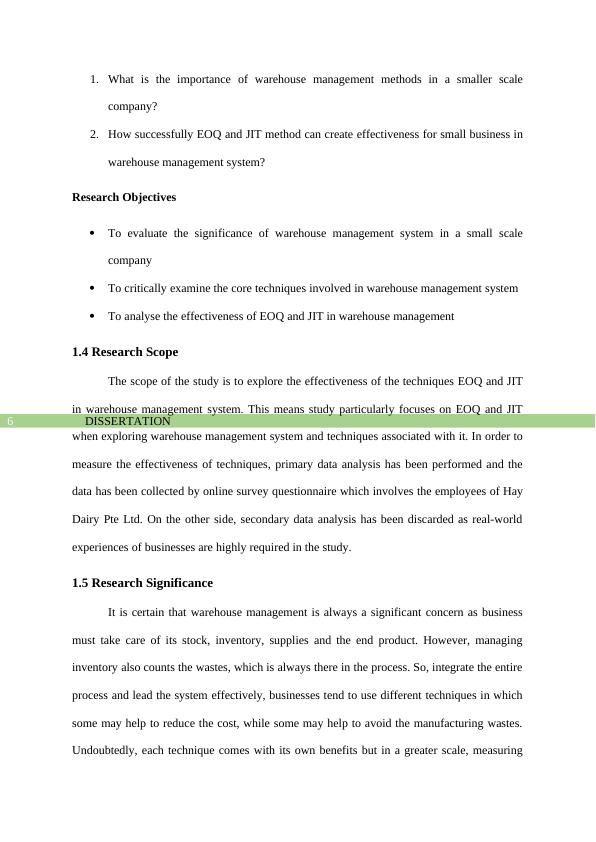
DISSERTATION7
the effectiveness of the used technique is a context of research of many academic scholars.
Even though, there are many techniques used in the warehouse management system but the
significance of this study in lies in the fact that the investigation in the research helps to learn
how JIT and EOQ are effective in warehouse management.
1.6 Summary
This chapter builds the backbone of the study as it provides a detailed background of
the study with respect to fundamental of warehouse management system, its importance in
small business and techniques used to manage the system. The chapter also provides research
objectives and questions derived from the background which are further reflected in literature
review in the following section.
the effectiveness of the used technique is a context of research of many academic scholars.
Even though, there are many techniques used in the warehouse management system but the
significance of this study in lies in the fact that the investigation in the research helps to learn
how JIT and EOQ are effective in warehouse management.
1.6 Summary
This chapter builds the backbone of the study as it provides a detailed background of
the study with respect to fundamental of warehouse management system, its importance in
small business and techniques used to manage the system. The chapter also provides research
objectives and questions derived from the background which are further reflected in literature
review in the following section.
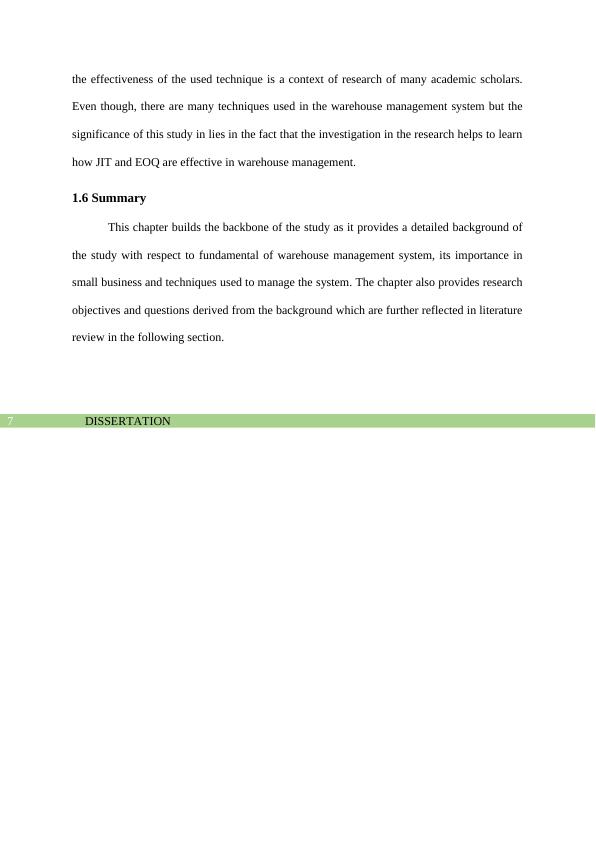
End of preview
Want to access all the pages? Upload your documents or become a member.
Related Documents
Impact of Just-in-time inventory on supply chain efficiency in Mozambique's Fast Food Sectorlg...
|28
|9881
|92
Operation Management assignment : Dasin Holdings Pvt Ltdlg...
|61
|10323
|29
Effectiveness of online advertising on customer purchase intentions: Morrison's Caselg...
|71
|13892
|471
Impact of Learning and Development Initiatives Paperlg...
|58
|13299
|323
A study of leadership skills necessary for management of group conflicts at Tesco UKlg...
|78
|14269
|393
The impact of effective logo design on branding and organizational profitabilitylg...
|71
|18159
|128
